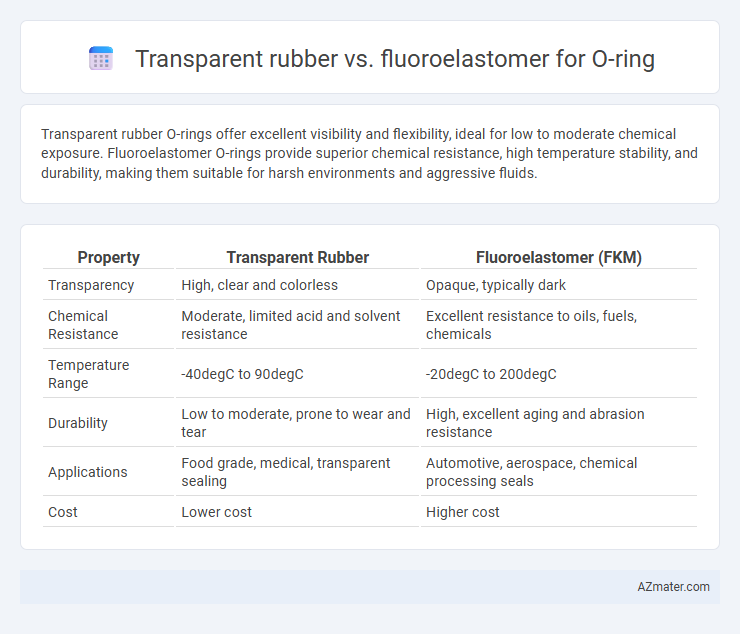Transparent rubber O-rings offer excellent visibility and flexibility, ideal for low to moderate chemical exposure. Fluoroelastomer O-rings provide superior chemical resistance, high temperature stability, and durability, making them suitable for harsh environments and aggressive fluids.
Table of Comparison
| Property | Transparent Rubber | Fluoroelastomer (FKM) |
|---|---|---|
| Transparency | High, clear and colorless | Opaque, typically dark |
| Chemical Resistance | Moderate, limited acid and solvent resistance | Excellent resistance to oils, fuels, chemicals |
| Temperature Range | -40degC to 90degC | -20degC to 200degC |
| Durability | Low to moderate, prone to wear and tear | High, excellent aging and abrasion resistance |
| Applications | Food grade, medical, transparent sealing | Automotive, aerospace, chemical processing seals |
| Cost | Lower cost | Higher cost |
Introduction to O-Ring Materials
O-ring materials such as transparent rubber and fluoroelastomer serve distinct applications based on their chemical properties and environmental resistance. Transparent rubber offers excellent flexibility and visual inspection advantages but has limited chemical and temperature resistance compared to fluoroelastomer, which excels in withstanding harsh chemicals, high temperatures, and aggressive environments. Choosing between these materials depends on the sealing requirements, operational conditions, and durability needed for specific applications.
Overview of Transparent Rubber
Transparent rubber offers excellent clarity and elasticity, making it ideal for applications requiring visual inspection and flexibility, such as medical devices and food processing equipment. It provides good resistance to water, oils, and some chemicals but generally lacks the high-temperature and chemical resistance found in fluoroelastomers. Fluoroelastomer O-rings excel in harsh chemical environments and extreme temperatures, while transparent rubber prioritizes visibility and moderate durability.
Key Properties of Fluoroelastomer
Fluoroelastomer O-rings offer superior chemical resistance, high-temperature stability up to 200degC, and excellent compression set resistance compared to transparent rubber options. Their low permeability to fuels and oils makes them ideal for aggressive environments requiring long-lasting sealing performance. Enhanced resistance to ozone, weathering, and aging distinguishes fluoroelastomer O-rings in demanding industrial and automotive applications.
Chemical Resistance Comparison
Fluoroelastomer O-rings exhibit superior chemical resistance, especially against hydrocarbons, oils, and aggressive chemicals, maintaining integrity in temperatures up to 200degC. Transparent rubber O-rings, often made from silicone or polyurethane, provide moderate chemical resistance but can degrade when exposed to oils, fuels, or solvents, limiting their use in harsh chemical environments. For applications requiring extensive exposure to acids, bases, and solvents, fluoroelastomers offer enhanced durability and longer service life compared to transparent rubber materials.
Temperature Tolerance Differences
Transparent rubber O-rings typically withstand temperatures up to 80degC to 120degC, making them suitable for low to moderate heat applications. Fluoroelastomer O-rings offer superior temperature tolerance, performing reliably in ranges from -26degC to 204degC or higher, ideal for extreme thermal environments. The enhanced chemical stability and heat resistance of fluoroelastomers make them preferred for automotive, aerospace, and chemical processing industries where temperature fluctuations are significant.
Mechanical Strength and Durability
Transparent rubber O-rings offer moderate mechanical strength and flexibility, suitable for applications with low to medium stress and limited chemical exposure. Fluoroelastomer O-rings exhibit superior mechanical strength, exceptional durability, and excellent resistance to high temperatures, chemicals, and abrasion, making them ideal for demanding industrial environments. Enhanced tensile strength and resistance to deformation make fluoroelastomers the preferred choice for long-lasting sealing solutions under mechanical stress.
Application Suitability: Transparent Rubber vs Fluoroelastomer
Transparent rubber O-rings excel in applications requiring visual inspection and aesthetic clarity, such as medical devices and food processing equipment, due to their excellent visibility and good resistance to water and mild chemicals. Fluoroelastomer O-rings offer superior chemical resistance, high-temperature tolerance up to 200degC, and excellent durability in aggressive environments like automotive fuel systems and chemical processing plants. Choosing between transparent rubber and fluoroelastomer depends on the specific application's need for transparency versus resistance to heat, solvents, and harsh chemicals.
Cost Analysis and Availability
Transparent rubber O-rings typically offer lower material and manufacturing costs compared to fluoroelastomer O-rings, making them more budget-friendly for applications with less demanding chemical resistance requirements. Fluoroelastomers, known for their superior chemical, temperature, and weather resistance, generally incur higher costs due to complex production processes and specialized raw materials, but they provide longer service life which can offset initial expenditures. Availability of transparent rubber O-rings is widespread across standard suppliers, while fluoroelastomer O-rings may require sourcing from specialized manufacturers, potentially affecting lead times and overall procurement expenses.
Environmental Impact and Safety
Transparent rubber O-rings typically have a lower environmental impact due to their easier recyclability and biodegradable potential compared to fluoroelastomers, which are known for their resistance to chemicals and high temperatures but contain fluorinated compounds that pose environmental hazards during production and disposal. Fluoroelastomers release harmful substances when incinerated and may persist in the environment, raising safety concerns related to toxicity and bioaccumulation. Choosing transparent rubber O-rings enhances sustainability and reduces health risks in applications where extreme chemical resistance is not critical.
Choosing the Right O-Ring Material
Choosing the right O-ring material depends on application requirements such as chemical resistance, temperature tolerance, and transparency. Transparent rubber offers excellent clarity and flexibility, making it ideal for visual inspections and non-aggressive environments, while fluoroelastomers provide superior chemical resistance, high-temperature stability (up to 200degC or higher), and durability in harsh conditions. Selecting fluoroelastomer O-rings ensures reliable sealing in automotive, aerospace, and chemical industries where exposure to fuels, oils, and aggressive chemicals is common.

Infographic: Transparent rubber vs Fluoroelastomer for O ring
 azmater.com
azmater.com